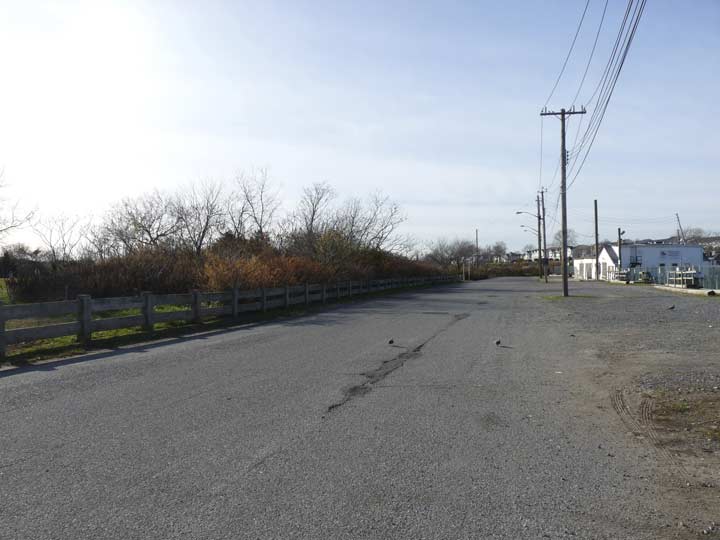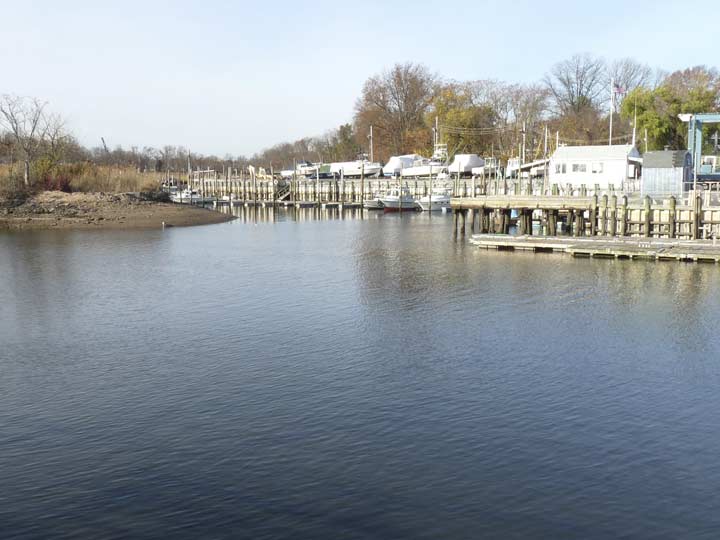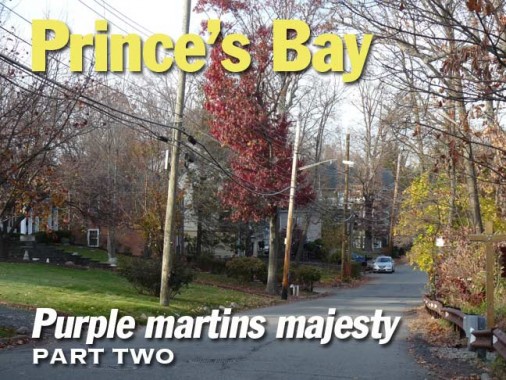One of the places I visited in 2005, and have only been in once or twice since, is Prince’s Bay, on the south shore of the island about 3/4 distance to the end of Staten Island and the southernmost place in New York State in Tottenville, Ward’s Point.
Confusion has existed for decades about the neighborhood’s correct spelling, though most signs have it correctly now, including the “official” sign on Amboy Road and Seguine Avenue shown here. After the Revolutionary War ended, New York City virtually divested itself of royal place names, though Prince Street in Manhattan and Kings Highway in Brooklyn are still there. According to tradition, Prince’s Bay is so-called because before the Revolution, a British prince, the Duke of Nassau, who later became William III (he co-reigned with his wife and first cousin Mary II as William and Mary), once anchored a vessel in the actual bay at the foot of today’s Seguine Avenue. The name of the area is properly spelled with an apostrophe, though variants due to mispronunciation like “Princess Bay” have appeared in print. The French Huguenot Seguine family were early settlers in the area and resided here for a couple of centuries.
Interestingly one of my sources has it that long ago, Prince’s Bay was known as Skunk’s Misery, but that’s not corroborated elsewhere. In Nassau County, there is a Skunk’s Misery Road in Locust Valley, and perhaps the two are connected in some manner.
When I left off in Part 1, I had just visited the various historic locales in southern Prince’s Bay, some of which are still standing in pristine condition (Seguine Mansion) horribly abandoned and uncared-for (Manee-Seguine House) and completely demolished (S.S. White dental products factory). Today, I’ll inspect the Lemon Creek area and then onto Prince’s Bay’s northern flank.

Though various maps over the years have tried to make Johnston Terrace longer and connect it to Hylan Boulevard a mile to the west, reflecting various development plans that haven’t panned out, the actual road is a glorified dead end that nonetheless provides access to Lemon Creek marina as well as Lemon Creek Park.
There is another section of Johnston Terrace west of here, separated from this section by Lemon Creek itself. The two sections were once connected by a hand-operated drawbridge; I wish I had been here when it was in operation, since it was unique to New York City. It had been put out of business years before Hurricane Sandy hit; I wish I had included this section of Prince’s Bay in today’s walk, since it’s fairly wild and undeveloped. Maybe on my next trip.

If you look at most paper maps of the region, and even Google, they render Lemon Creek as relatively short. In fact they only show Lemon Creek’s wider, more navigable section. Some years ago I prepared a map showing where it turns up north of here, as it runs through several open spaces and backyards in the area with, as we’ll see, a few secluded public areas. The creek also has a few unnamed tributaries. Main roadways are discreetly bridged over these small trickling creeks, while in some cases the creek is carried underground only to pop up again.
At the west end of Johnston Terrace is an unusual bird sanctuary created for purple martins, a migrating bird in the swallow family, as well as birdhouses for other species. The purple martin colony was created in 1916 by area resident Howard Cleaves, who built a pair of birdhouses for them behind his house on Purdy Place. Cleaves moved away in 1918, but didn’t forget about the martins and built these unusual birdhouses for them here on Johnston Terrace.
The martins migrate to South America for the winter months, but spend spring and summer here. Native Americans discovered that the martins would nest in empty gourds that they would hang on trees. The martins were useful because they preyed on insect pests, and the hanging gourds made them less susceptible from atttacks from hawks, raccoons, cats, etc. The martins got used to the gourds, so the present birdhouses are shaped like them. The birds became so dependent on man that today, no eastern purple martins nest in the wild — only in shelters provided by people.
Plenty of other bird species are tenanted here.
Raritan Bay is an indentation of the Atlantic Ocean between southwest Staten Island and Sandy Hook, NJ. The bay as well as Raritan Borough in Middlesex County, NJ and the Raritan River are named for a subdivision of the Lenape Native American tribe. In Native American Place Names in NYC, Robert Steven Grumet asserts that the name means “point on a tidal river.”
Here, Raritan Bay has an expansive beach but unlike the South Beach area in Arrochar and Midland Beach, it’s never been promoted as a safe swimming area, though no doubt Staten Islanders find it a decent area for fishing and sun bathing in season.
Looking west from the end of Johnston Terrace we see the Prince’s Bay Light as well as one of the remaining buildings in the Mount Loretto Orphanage. The current lighthouse was constructed in 1864 for the sum of $30,000 which was approved by Congress. The attached lightkeepers cottage was completed in 1868. Previous lights had shone from Prince’s Bay since 1837. The portion of the grounds where the lighthouse stands is not open to the public, but Lighthouse Friends (linked above) has full details, as well as some close-up photos of one of NY State’s oldest lighthouse buildings. Meanwhile, I visited several of the remaining lighthouses in the Staten Island-New Jersey area on a boat tour in September 2012, a few weeks before Hurricane Sandy. The original lighthouse was deactivated in 1922, with the range light in the foreground erected in 1953.
A feature of this beach until a few years ago was a series of fascinating rock sculptures built by Staten Island Zoo employee Douglas Schwartz. State agencies banned him from continuing the hobby in 2011, citing safety regulations.
Some of the Bluffs of Mount Loretto can also be seen from here. At a full 85 feet above Prince’s Bay they are the tallest ocean-facing cliffs in New York State. They have been here since the age of dinosaurs a good 135 million years ago.
One of the tallest structures in southern Staten Island, the Old Church of Saints Joachim and Anne, constructed on the Mount Loretto grounds in 1891, can easily be seen above the treeline. The church was used for exterior shots in the Mob classic The Godfather in 1972. While most of the church burned down in 1973 it was rebuilt three years later. The church is no longer a parish church but is used for various functions by the Mount Loretto orphanage.
The founder of Mount Loretto, Father John C. Drumgoole (1816-1888) immigrated from County Longford, Ireland, in 1825 to join his mother in America after his father’s death, and took work as a shoemaker when he became of age. He became the sexton and janitor of St. Mary’s parish in Manhattan’s Lower east Side in 1844, the third oldest NYC parish, and took a special interest in the thousands of homeless and orphaned children wandering the streets after coming to America in the aftermath of Ireland’s potato famine of the 1840s, or were left parentless during the Civil War. He provided food and shelter to these destitute youth in the basement of St. Ann’s for 21 years.
Drumgoole had always aspired to the Catholic priesthood and after attending St. John’s College in the Bronx, now Fordham University and the Seminary of Our Lady of Angels near Niagara Falls, he was ordained at age 53 in 1870. He continued to help homeless children in the succeeding years.
In those days tuberculosis and influenza ran rampant in the city’s poorer sections and it was thought that fresh air played a large part in recuperation and recovery. Thus, Fr. Drumgoole sought property well outside of town and in 1882 purchased the land in southwest Staten Island that is now known as the Mount Loretto orphanage.
In March 1888, Fr. Drumgoole died during an illness acquired when he was caught out during the Blizzard of ’88 that month.
In 1941, what is now the Korean War Veterans Parkway was constructed and named for Father Drumgoole. The parkway’s service roads still bear his name.
Totemic art sculpture on the Raritan Bay beach. I’m reminded of the Martian leader in 1959’s Angry Red Planet.
The remains of a dock appear on the beach at the end of Seguine Avenue, which here is reduced to a sandy/muddy track through the phragmites. Presumably the dock was once used by the Seguine family as well as the various buisnesses centered in what became the S.S. White dental works.
The name on the sign indicates that the true spelling of the neighborhood is still in dispute in some quarters. In fairness I’m told that locals pronounce it “Princess” Bay, no matter what the spelling. This spelling is carried through on the organization’s website. It was founded in 1934 to assist yachters, clammers, sport and commercial fishermen in the area.
Heading north on Seguine again toward Hylan. Two different philosophies in residential construction.
OK, taking a left turn on Hylan Boulevard, the sidewalk peters out, as it often does in this land of automobiles. It’s not easy to cross 6 lanes of fast and furious traffic here, so I didn’t — I walked in the bike lane.
Staten Island’s south shore features a lot of new construction — this end was the last to ve developed after the bridge opened in 1964, and when I started coming out here on bus rides and hikes as early as the early 1970s, a lot of it was still somewhat rural. This residence likely predated the bridge by a few decades.
Inez Street, a dead end on Hylan Blvd. just a bit east of Lemon Creek, looks exactly the same as when I first saw it in the 1970s. There are a couple of homes on it but it does not appear on google maps, which is otherwise thorough.
Inez is Spanish for Agnes. For many years in the 19th Century Spanish immigrants had lived in a nearby cottage development at the end of Poillon Avenue in Huguenot, which included the residence of activist/journalist Dorothy Day for many years, but the properties were sold and razed in 2000 before they could be landmarked. This street name could be reflective of their presence in the area.
This is also the location of one of the remotest bus stops in New York City — it’s not even paved. S78 buses to the St. George Ferry and the S59 bus to the Staten Island Mall stop here.
Hylan Boulevard is carried over Lemon Creek just west of Bayview Avenue. This view is looking south toward the marina at Johnston Terrace.
Turning north on Bayview, which is a very old road — it turns up on maps as far back as 1874. It does without a sidewalk for much of its length.
Near Vail Avenue Bayview is bridged over a Lemon Creek tributary. For want of a batter name, I’ll hereby call it the Bayview Avenue Bridge.
The State of New York Department of Environmental Conservation has set up this relatively new sitting area overlooking Lemon Creek. It’s a handy place to sit down and ponder your inadequacies while enjoying twittering birds and imagining you are far away from New York, which, physically, you are, from Manhattan, at least.
This expansive house with a front and side porch and octagonal corner tower is at the corner of Bayview and Finlay Avenues. As you go north you see several smaller houses, but older.
As stated Bayview Avenue turns up on maps as early as 1873. This trio of buildings are likely a century old, though they have modern siding of various ages. Note the wide lawns and lack of sidewalks. The wide lawns, at least, are counter to the modern idea of maximizing space with parking areas and garages.
Bayview Avenue is bridged over Lemon Creek at Excelsior Avenue. I remember reading somewhere that this had been a retractable bridge at one time (which is pulled along a track to open), but if it was there, it was replaced long ago. Excelsior Avenue takes its name from the motto of New York State, a Latin term meaning “higher” or “upward.”
The part of Bayview Avenue between the creek and the Staten Island Railway overpass is where you will find the greatest concentration of Bayview Avenue’s classic buildings. Some seem to have been built as early as 1885 and many retain original ornamentation and appearances. Special attention has been given to window treatments.
Bayview Avenue runs through a shallow valley at this point. I’d guess that when the Staten Island Railway was elevated on a trestle in the 1930s, this adjacent dwelling had to be raised as well. It now takes a 3-flight stair climb to reach it.
These dwellings on either side of the railroad feature tall conifers on their properties facing the sidewalk, a decent cooling measure in the warm months.
Turning right on Amboy Road from Bayview, this is the landmarked Abraham Wood House, 5910 Amboy Road near Seguine Avenue, built in about 1840 by the oysterman and farmer. Note the eyelet windows on the second floor.
From the NYC Landmarks Preservation Commission’s 1973 report:
“This simple frame house, built in the Greek Revival style, was erected as a farmhouse shortly after Abraham J. Wood acquired the land from Joseph Sprague in September of 1840. It is located on a low, grassy knoll set back from Amboy Road, which is one of the oldest roads on the island, having been laid out in May 1709. By the mid-18th Century it had become one of the major routes between New York and Philadelphia for the stages forced to bypass the New Jersey Meadows.”
Other notable buildings in Staten Island
This pair of classic street signs appears outside an adjoining home. This is not a Staten Island intersection, so the signs likely came from elsewhere.
Another pair of classic, if not historic, dwellings on Amboy Road between Bayview and Seguine Avenues.
1/4/16
